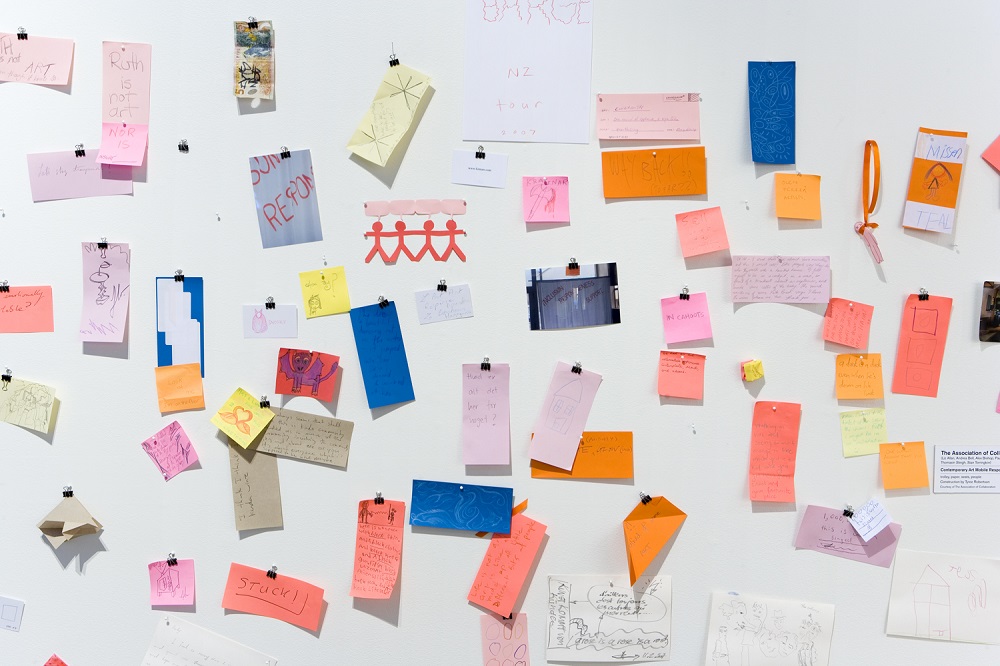ARTISTS Liz Allan, Fiona Amundsen, Cindy Bernard, Steve Carr, Kah Bee Chow, Octavia Cook, Pip Culbert, Simon Denny, Daniel du Bern, Rachel Easting, Et Al., Fez Fa'anana, Brian Fuata, Darren Glass, Brett Graham, Jacquelyn Greenbank, Jason Greig, David Hatcher, Richard Killeen, Gregor Kregar, Simon Lawrence, Janet Lilo, Andrew McLeod, Gina Matchitt, Judy Millar, Michael Morley, Simon Morris, Seung Yul Oh, Miranda Parkes, Kim Paton, Nova Paul, Davor Popadich, Jeena Shin, Ngataiharuru Taepa, The Association of Collaboration, Rachael Rakena, Rohan Wealleans, Elvon Young CURATOR Heather Gailbraith PUBLICATION essays Cassandra Barnett, Peter Brunt, Rachel Carley, Anna Dean, Heather Galbraith, Harold Grieves, John Hurrell, Robert Leonard, Louise Menzies, Kathryn Mitchell, Kate Montgomery, Gregory O'Brien, Ryan Moore, Sarah Farrar, Jessica Reid, Virginia Were SPONSOR Telecom NZ
Prospect: New Art>New Zealand is the third full-gallery Prospect show surveying recent developments in New Zealand art. Curated by Heather Galbraith, it's organised in three main parts.
‘Quiet Riot: Contemporary Abstraction’. Judy Millar's large paintings are energetic battles of paint application and removal. Two of them hang on a rudimentary wooden wooden wall in the centre of the space. For Jack Wrap Falls (2007), Seung Yul Oh wraps the space between three structural columns in translucent azure-blue material. Ngataiharuru Taepa's painted pou He Rau Kawakawa (2006) refers to kowhaiwhai's multiple meanings—as figurative, symbolic, and abstract. There are also wall paintings by Jeena Shin and Simon Morris.
‘Parallel Multiverse: Augmented Reality and Altered States’. Et Al.'s Further to National Interest (2006) is an installation of lightboxes on easels. It's soundtrack lectures us about the polarisation of radical communities. Jacquelyn Greenbank's gimmicky knitted sculptures include a BBQ and a tandem bike. Andrew McLeod's Green Rainbow (2006) is an eerie fantasy painting of a sickly-green, zero-gravity underworld. David Hatcher collaborates with LA-based artist Cindy Bernard to create The Inquisitive Musician: Screen Tests, translating seventeenth-century satirical German cartoons.
‘A Return to the Real: A Reconfiguration of the Everyday’. Nova Paul’s 16mm film Pink and White Terraces (2006) uses colour separation techniques to examine life in the suburbs. In Where Everyone Gets a Bargain (2005), Gina Matchitt decorates tote bags for five major companies—the Warehouse, Liquor King, Countdown, KFC, and Pak n Save—with pixelated Perler beads, translating their slogans into Māori. Steve Carr's Popcorn Mountain (2007) is a pile of popcorn equal to his own weight.
The Association of Collaboration's Contemporary Art Mobile Response Unit (2007)—a bright orange cart equipped with pencils and post-it-notes—gives audiences the chance to voice their opinions on post-its. It declares Carr's Popcorn Mountain to be the most popular work. They publish statistics: ‘23.52% wanted to eat the popcorn, 8.82% of respondents ate a piece of popcorn, 2.94% chastised the popcorn numbers, 29.4% wanted to climb or play with the popcorn …’ etcetera.
Kim Paton's Everything Thought and Remembered (2007) fills the Reading Room. It's made of recycled building materials that would otherwise be considered useless. A space to stop, think, and rest, it is intended to be reconfigured after the show as a ‘roof-top bar, a mobile library, a shelter, etc’. In the foyer, Multiple Cabinets is a curio cabinet of multiples for sale. In the front entrance window spaces, video works—by Kah Bee Chow, Gregor Kregar, Simon Lawrence, Tahi Moore, Elvon Young, and Davor Popadich—loop continuously. The public programme includes panels, workshops, symposia, and discussions about private art collecting,
Galbraith calls her show a ‘dizzying mix of works reflecting different sensibilities’. In the Listener, Aaron Kriesler says ‘Prospect seems to be a poisoned chalice. This kind of grab-bag exhibition signals a shift in the power balance, a changing dynamic between artists and curator. A decade or so ago, the curator would have asserted a particular take/approach and the artist would have been given a clear mandate. But this current mix provides some challenges for the audience: with no conceptual overview, we are left wondering how this cluster of work came together and what it says about contemporary art in New Zealand.’




















































































































































